MMC3000
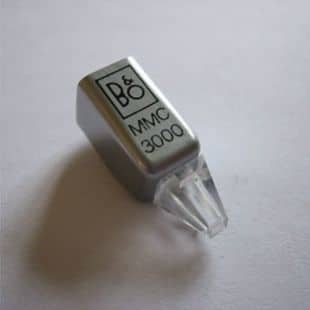
The MMC3000 was the basic model in the all new range of cartridges.
It was designed for use with the lower end of the range such as the Beogram 1100 and Beocenter 1800 and 3600. It has a spherical diamond stylus.

The MMC3000 was the basic model in the all new range of cartridges.
It was designed for use with the lower end of the range such as the Beogram 1100 and Beocenter 1800 and 3600. It has a spherical diamond stylus.
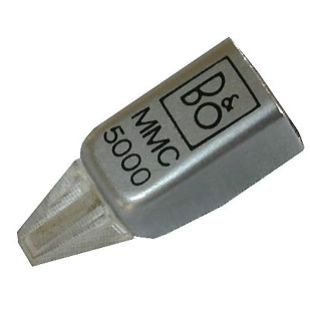
This was the cartridge specified for the Beogram 3400 and had a Shibata profile diamond. This is quite a rare cartridge to find these days as many 3400s did not have the CD4 decoder fitted and hence did not require this cartridge..
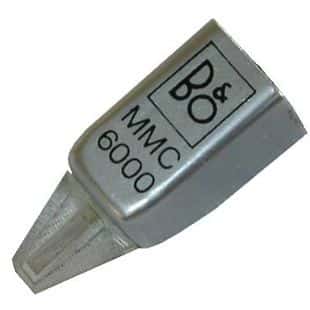
Bang & Olufsen’s (then) most accomplished pickup cartridge was fitted to Beogram 6000.
The MMC principle was adapted to track 4-channel records: both Quadradiscs and SQ. MMC 6000 would track both mono and stereo records with the utmost fidelity. It was designed for record-players with tangential arms. The stylus was the Pramanik diamond, named after its inventor: engineer S K Pramanik from Bang & Olufsen’s Laboratories.
The diamond’s radii were 7 um/2 x 50 um. It was a refinement of the elliptical shape, rather like the shape of the cutter-head, and enabled greater contact with the undulations of the record groove. The cantilever was made of berylium – a material which is harder yet lighter than popularly-used aluminium. Effective tip mass was 0.22 mg. Compliance was higher than 30×10-6 cm/dyne. Recommended- stylus pressure was 1g. The total frequency range was 20-45.000 Hz.
In the audible range: 20-15.000 Hz there is less than 1.5 dB variation and in the inaudible range 20,000-45,000 Hz where the carrier frequencies lie, the pick-up fulfils RCA/JVC’s specifications for a Class A discrete 4-channel pick-up cartridge. Each cartridge is an integrated, individually calibrated unit. The stylus unit is not separately replaceable since it is part of the integrated unit. An individual frequency response curve traced on a Bruel & Kjaer level recorder and a complete Calibration Card were enclosed with every MMC 6000 sold.

This top-operated receiver was not just exciting in appearance, it was also designed to facilitate operational comfort.
Primary controls were easily accessible, while the rarely used secondary regulators were concealed. The large tuning scale had calibrations in MHz and channel numbers. Tuning accurately to a desired station was child’s play because the large transparent slider was also provided with three small thumbwheels which assisted fine tuning.
Your three favourite stations could be pre-set by individual controls which were safely concealed beneath a sliding panel on the upper right hand side of the set. Subsequent programme selection was by easy pushbutton. The use of Field Effect Transistors (FETs) and Automatic Frequency Control (AFC) ensured optimum FM reception and compensated for weak signal conditions during tuning.
The amplifier’s power output was 2×15 watts RMS or 40 watts total music. Ambiophonic reproduction could also be obtained simply by connecting four loudspeakers, 2 in front and 2 to the side. In this way you could obtain an ‘extended’ stereo reproduction, a more realistic recreation of musical experiences recorded, for example, in a concert hall, because ambience or room information were included as well as direct musical information. There was a push button, the ‘ambio filter’, by which you could damp or reduce the highest tones (treble) reproduced in the side speakers. This was sometimes desired since the reflected sound which is reproduced in the side speakers is mostly mid-range tones. By damping high tones in the side speakers you could obtain a more natural sound reproduction.
Balance regulation was solved in a unique way in Beomaster 1001. Volume was controlled by two sliders, one for right and the other for left channel. The two sliders cold be operated together with one grip or separately, so that the balance between the channels could be adjusted as desired. The receiver’s slim, compact cabinet allowed several playing positions. Mounted on a wall (with special mounting bracket), slightly slanted (by special supports fitted to its base), or the traditional horizontal position. There were connections for record-player (switchable between high and low ohms), tape-recorder, headphone and four loudspeakers. A light indicated when the receiver was switched on, when the FM programme source was in use and whether a programme was in mono or stereo.
Receivers and amplifiers with the ambio function were products which, apart from stereo, could also reproduce the ambience or sound information of a room. Ambient information was included on most stereo vinyl recordings but could not be reproduced by a sound system with two loudspeakers or an ordinary stereo amplifier. Bang & Olufsen systems with the ambio function had facilities which electronically subtracted the difference signal (i.e. the difference between left and right channels) which contained ambient information. This information was fed into two extra loudspeakers which were placed as side speakers in a room. Ambiophony was an extension of stereo reproduction and enhanced the sense of realism. It could be used with nearly all stereo programme materials.
FM room aerial
In order to receive FM programmes, an FM aerial must be connected to the Beomaster 1001. Within a certain radius of the transmitter you could use the Bang & Olufsen FM room aerial, type 8902010. This aerial was easily fitted and the telescopic elements could be pulled out and positioned favourably.
Wall mounting
If desired, the Beomaster 1001 could be mounted on a wall by means of a special bracket. type 8920243. The bracket was screwed onto the wall and the receiver easily hung in position.
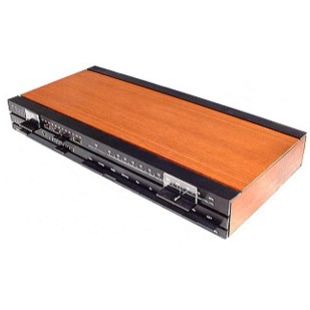
Beomaster 1100 in 1977/78 was a powerful, sensitive and compact unit incorporating an FM tuner and stereo amplifier.
The tuner had facilities for presetting four favourite stations, and once these had been permanently tuned, the programme of your choice could be instantly selected just by pressing a button. There was also a large slider and scale for manual tuning. An AFC (Automatic Frequency Control) switch was provided to help capture weak stations and keep them correctly tuned.
The amplifier section had a power output of 2 x 22 watts RMS with minimal distortion – less than 0,3% at full power. There were connections for two pairs of loudspeakers, a record player, headphones and a tape or cassette recorder (for which A monitoring facilities were also included).
Beomaster 1100 could be made up as part of the Beosystem 1100, together with other compatible Bang & Olufsen products.
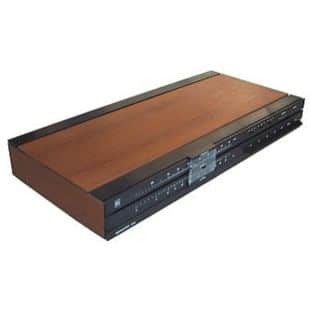
Beomaster 1700 Type 2607 was a tuner designed to complement BeoLab 1700 amplifier.
“This title might suggest a paradox to many readers. And in a way you are right. But there is a reason why Bang & Olufsen has separated this otherwise perfectly integrated high-fidelity system. The combination possibilities in Beosystem 1700 are so numerous that for many people the entire system is unnecessary. The essential part of the system is BeoLab 1700: a 2 x 20 watts RMS amplifier with ambiophonic stereo facilities.
The tuner, Beomaster 1700, the cassette-recorder, Beocord 1700 and the record player, Beogram 2000 cover nearly all existing programme sources for the reproduction of music. Beovox 2702 loudspeakers complete the system. Beovox 1702 are recommended as side speakers for ambiophony, if this extra sound experience is desired. Now it is up to you to put your ideal Beosystem 1700 together. ” – 1974 Catalogue
Beomaster 1700 was a highly sensitive FM tuner with manual tuning on the entire scale, plus 3 pre-set stations. The FM scale covered the 87.5-104 MHz range, channel numbers were clearly written on the scale to aid easy tuning. There were pre-set facilities for P1, P2 and P3 so that subsequent programme selection was by easy push buttons. An illuminated indicator made tuning easy and the AFC (automatic frequency control) facility assisted fine tuning. The tuner was highly sensitive and distortion was less than 0.5 %. Frequency range was 20-15.000 Hz, the same as that transmitted from FM stations. Field effect transistors, integrated circuits and ceramic filters were used in Beomaster 1700.
This tuner offered choice in the range but don’t buy this imagining that you will be getting something akin to a Beomaster 5000. Comparing the two is invidious as the cost was far different and the contents of the Beomaster 1700 case were much simpler. It did allow use with devices like the Beocord 2400 which had a built in amplifier but the tuner would be a very low cost choice.
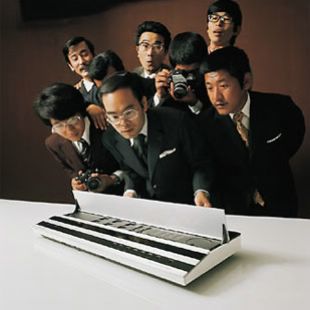
The 1970’s were exciting times for Bang & Olufsen. Another breakthrough during this decade was Beomaster 1900, a radio receiver and amplifier launched in 1976. Once again, design and operation differed dramatically from other contemporary products.
Originally designed by Jacob Jensen, Beomaster 1900, together with Beomaster 2400-2 were two advanced FM stereo receivers. They had identical technical specification and performance. Both were easy to use and easy to live with. Beomaster 2400-2 had the additional convenience of a cordless ultrasonic remote control module by which you could operate radio, amplifier and Beogram 2400 or 4004 record deck from a distance. Both receivers had touch-sensitive controls for operating the features and functions you used every day. All the secondary switches and adjustments were protected beneath a hinged lid, but an illuminated readout panel showed you the set’s operational status at a glance.
Beomaster 1900 boasted a powerful 2 x 30 watts RMS amplifier with distortion of less than 0,13%, five pre-set FM stations and comprehensive connection facilities. To operate it you simply touch the application “dimples” on the set’s front panel. The radio section had 4 pre-set stations which could be summoned at a touch and the phase-lock loop decoder provided excellent stereo separation even in difficult reception conditions The volume level could be pre-set at low, medium or high, and the music would always start at this level however much the volume control was altered last time the set was used.
The sets’ controls were divided into primary and secondary functions. The latter, which were less frequently used, were placed underneath the hinged aluminium panel where they were protected from dust and accidental movement.
A clear distinction was therefore made between the primary choice – accessible through a light touch – and the secondary choice, concealed under a lid hiding what the user did not need for daily use. At a stroke, what had been the norm for hi-fi in the past, with its macho grip and buttons, was eliminated. Instead, designer Jacob Jensen created a new design language, flat ‘flush-designed’ and electronically communicating, which did not target a few techno-freaks, but a much wider audience who wanted music rather than hi-fi equipment.
Beomaster 1900 had connections for two pairs of speakers, headphones, record player and cassette recorder. The receiver won the ID Award in 1976.
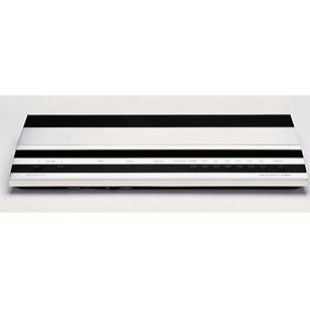
The 1970’s were exciting times for Bang & Olufsen. Another breakthrough during this decade was Beomaster 1900, a radio receiver and amplifier launched in 1976. Once again, design and operation differed dramatically from other contemporary products.
Originally designed by Jacob Jensen, Beomaster 1900, together with Beomaster 2400-2 were two advanced FM stereo receivers. They had identical technical specification and performance. Both were easy to use and easy to live with. Beomaster 2400-2 had the additional convenience of a cordless ultrasonic remote control module by which you could operate radio, amplifier and Beogram 2400 or 4004 record deck from a distance. Both receivers had touch-sensitive controls for operating the features and functions you used every day. All the secondary switches and adjustments were protected beneath a hinged lid, but an illuminated readout panel showed you the set’s operational status at a glance.
Beomaster 1900 boasted a powerful 2 x 30 watts RMS amplifier with distortion of less than 0,13%, five pre-set FM stations and comprehensive connection facilities. To operate it you simply touch the application “dimples” on the set’s front panel. The radio section had 4 pre-set stations which could be summoned at a touch and the phase-lock loop decoder provided excellent stereo separation even in difficult reception conditions The volume level could be pre-set at low, medium or high, and the music would always start at this level however much the volume control was altered last time the set was used.
The sets’ controls were divided into primary and secondary functions. The latter, which were less frequently used, were placed underneath the hinged aluminium panel where they were protected from dust and accidental movement.
A clear distinction was therefore made between the primary choice – accessible through a light touch – and the secondary choice, concealed under a lid hiding what the user did not need for daily use. At a stroke, what had been the norm for hi-fi in the past, with its macho grip and buttons, was eliminated. Instead, designer Jacob Jensen created a new design language, flat ‘flush-designed’ and electronically communicating, which did not target a few techno-freaks, but a much wider audience who wanted music rather than hi-fi equipment.
Beomaster 1900 had connections for two pairs of speakers, headphones, record player and cassette recorder. The receiver won the ID Award in 1976.

Beomaster 2000 at the time of its introduction in 1974 was an all-new model. The FM/AM stereo receiver was constructed to facilitate simple, logical operation.
Five FM stations could be pre-selected. Secondary controls which are not used daily were hidden under sliding panels. For example, the five FM pre-selectors, controls for AFC and muting (silent tuning), were discretely hidden away from view until such time as you needed them.
The construction of the stereo decoder was based upon a phase lock system which ensured constant high separation of channels. Manual tuning on the large FM/AM tuning scale was by means of a plain circular disc which was flush-mounted into the control panel. The tuning scale was illuminated and a light indicator assisted accurate tuning on an FM station. The AM section, (long and medium waves), had ceramic filters which enabled good separation between stations.
The newly developed automatic volume control effectively achieved a good balance between the weak and the strong AM stations. Darlington output circuits in the amplifier section produced 2 x 40 watts RMS or 150 watts total music, with less than 0.1 % harmonic distortion. One of the TAPE connections facilitated AB monitoring. It was possible to copy from one tape recorder to the other without having to fiddle with cables and sockets. There were sockets for two pairs of loudspeakers and for stereo headphones.
Two tape recorders could be connected and could be switched to enable copies of tapes to be made, in either direction. The set was housed in a large flat cabinet of a similar style to the Beomaster 1200 range, though the ‘slide rule’ pointer was replaced with a conventional dial, operated by a large flush aluminium wheel. A flywheel beneath this made manual tuning very smooth and the large diameter of the control, coupled with the now familiar dual light tuning indicator, also made it very accurate.
To complement slim appearance of the cabinet, a wire prop at the rear could be folded down, tipping the whole machine forward slightly enabling the controls and lights to be viewed more easily.
FM room aerial
Within a certain radius of the FM transmitter you could use the Bang & Olufsen room aerial, type 8902010. The aerial was easily fitted and the telescopic elements positioned as required.
This is one of the forgotten Beomasters. It utilised an amplifier design that would prove to be the most successful for B&O. It formed the basis for all the great amplifiers to follow in the range. Wonderful control of bass and plenty of reserve.
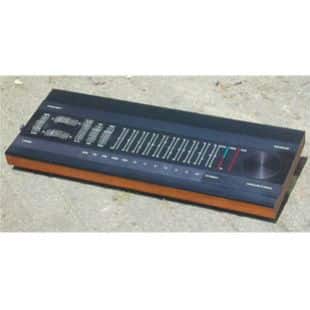
Beomaster 3400 Type 2802 was a 4-channel receiver whose out put was stated as 4 x 20W or 2 x 30W, depending on how it was configured.
This receiver was a development of the Beomaster 2000 but as well as being quadraphonic, was FM only. The tuning scale was extremely unusual being a series of vertical scales rather than a single horizontal one. Despite the huge length thus provided, it still only read up to 104!
It was designed to be partnered by the Beogram 3400 which could provide the correct 4 channel input as well as the stereo cassette player, the Beocord 2200. S45 or P45 speakers made up the rest of the system.